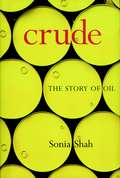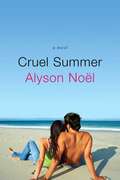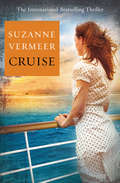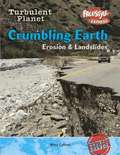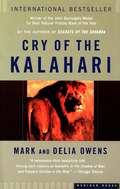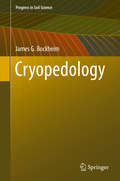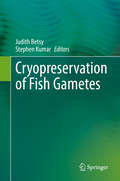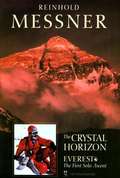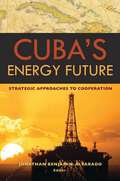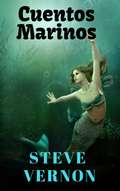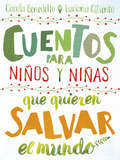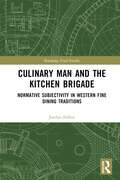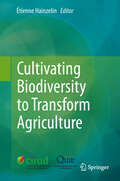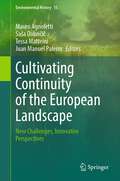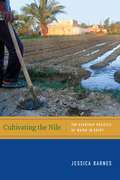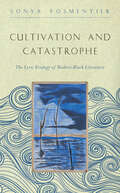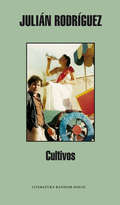- Table View
- List View
Crude: The Story of Oil
by Sonia ShahCrude is the unexpurgated story of oil, from the circumstances of its birth millions of years ago to the spectacle of its rise as the indispensable ingredient of modern life. In addition to fueling our SUVs and illuminating our cities, crude oil and its byproducts fertilize our produce, pave our roads, and make plastic possible. "Newborn babies," observes author Sonia Shah, "slide from their mothers into petro-plastic-gloved hands, are swaddled in petro-polyester blankets, and are hurried off to be warmed by oil-burning heaters." The modern world is drenched in oil; Crude tells how it came to be. A great human drama emerges, of discovery and innovation, risk, the promise of riches, and the power of greed.Shah infuses recent twists in the story with equal drama, through chronicles of colorful modern-day characters -- from the hundreds of Nigerian women who stormed a Chevron plant to a monomaniacal scientist for whom life is the pursuit of this earthblood and its elusive secret. Shah moves masterfully between scientific, economic, political, and social analysis, capturing the many sides of the indispensable mineral that we someday may have to find a way to live without.
Cruel Summer
by Alyson NoëlThis was supposed to be my best summer yet, the one I've been working toward since practically forever. Now I'm being banished from everything I know and love, and it just doesn't make any sense.
Cruise
by Suzanne VermeerA woman learns that her husband has been living a secret life she could never have imagined Frank and Helen's anniversary cruise is going perfectly, until the unthinkable happens and Frank disappears. Helen does everything she can to find her husband, but is ultimately forced to return home, alone and distraught.After spending the next few months searching, Helen hears from someone who has news of her husband. But not the news she hoped for: Helen learns that Frank was leading a double life. It becomes increasingly apparent that the man she married had a dark side Helen could never have imagined. Suzanne Vermeer, the bestselling mystery writer in the Netherlands, spins this story with unparalleled suspense.
Crumbling Earth: Erosion and Landslides (Turbulent Planet)
by Mary ColsonWithout notice, Earth's surface can change drastically and dramatically. As this exciting drama fully plays out on each page of this series, readers confront the physical and social impact of events and their aftermath. Geography and social science are made frighteningly real and relevant, as is the need for conservation and preventive measures. Each title includes a survival guide that recaps highlights from the book and provides a checklist of survival tips and precautions.
Crusoe's Daughter
by Jane GardamIn 1904, when she was six, Polly Flint went to live with her two holy aunts at the yellow house by the marsh - so close to the sea that it seemed to toss like a ship, so isolated that she might have been marooned on an island. And there she stayed for eighty-one years, while the century raged around her, while lamplight and Victorian order became chaos and nuclear dred. Crusoe's Daughter, ambitious, moving and wholly original, is her story.
Crusoe's Daughter
by Jane GardamIn 1904, when she was six, Polly Flint went to live with her two holy aunts at the yellow house by the marsh - so close to the sea that it seemed to toss like a ship, so isolated that she might have been marooned on an island. And there she stayed for eighty-one years, while the century raged around her, while lamplight and Victorian order became chaos and nuclear dred. Crusoe's Daughter, ambitious, moving and wholly original, is her story.
Crusoe, the Worldly Wiener Dog: Further Adventures with the Celebrity Dachshund
by Ryan BeauchesneThe New York Times bestselling and 2018 Animal StarPeople's Choice Award-winning popular blogger, internet sensation Crusoe, the Celebrity Dachshund returns with a beautiful and whimsical book full of heartwarming and goofy photographs of his around the world travels in Crusoe, the Worldly Wiener Dog.Join the photogenic Crusoe as he leaves fame and fortune behind to expand his horizons, get his passport stamped, and journey across the globe to eat delicious food, relax on beautiful beaches, dig lots of holes, and generally enjoy all that celebrity travel has to offer. You'll also get to see a little of his "staycations" and life at home between travels.Jet-setting is what dachshunds do best. From Switzerland’s Alps and Mexico’s Mayan temples to Italy’s seaside villages and France’s Eiffel Tower—as well as various locales throughout the U.S. and Canada—Crusoe shares his wit and wisdom on appreciating culture, fine wine, and haute cuisine, always dressing for the occasion, and maybe learning a thing or two about what really matters most in life along the way.In hundreds of brilliant color photographs, see the charming and charismatic mini-doxie embark on such thrilling adventures as…* Hitting the streets of New York City as The Wiener of Wall Street* Stalking evildoers as Batdog * Strolling Hollywood’s Walk of Fame (with his own star)* Going out on a dinner and movie date with the lovely Paisley* Digging for fossils at Dinosaur Provincial Park* Playing doctor and dentist to his sidekick brother, Oakley* Drinking at the notorious Bar Vitelli, shooting location of The Godfather* Recovering from back surgery with lots of love and rehabilitating in style * Tasting a beignet at New Orleans’s famous Café du Monde* Exploring his German heritage as a “badger dog”—and discovering what wiener schnitzel actually is…And so much more!
Cry of the Kalahari
by Mark James Owens Cordelia Dykes OwensThis is the story of the Owens' travel and life in the Kalahari Desert. Here they met and studied unique animals and were confronted with danger from drought, fire, storms, and the animals they loved. This best-selling book is for both travelers and animal lovers.
Cry of the Wild: Life through the eyes of eight animals
by Charles Foster'Evocative and beautifully written, it's a deeply immersive read' Observer'Enchanting and emotional...personifies its characters as they navigate the new wild and its trials.' Chris Packham'Charles Foster is the most original voice in nature writing today - funny, urgent, poetic, philosophical and deeply moving' Patrick Barkham'Utterly exhilarating... This book demands we change our ways' Lee Schofield'There aren't many writers like Charles around... a deeply thought-provoking book' James Aldred'Reading this book feels like being made suddenly omniscient. In other words, you really have to' Tom Moorhouse'Astonishingly playful, humorous, immensely varied and outrageously intelligent... The most inventive British writer presently at work on the theme of nature' Mark CockerWhat is it like to live in a world built by humans? These eight genre-blending stories reveal the complexity, beauty and fragility of wild lives - a brilliantly modern twist on classics like Watership Down and Tarka the Otter.A fox, grown strong on pepperoni pizza from the dustbins of the East End, dances along a railway track towards Essex, the territory of wild foxes and wilder huntsmen.An orca, mourning the loss of her mother in a valley west of Skye, knows that she must now lead the pod as matriarch. She swims again through her childhood, thinking about the old ways, the old roads, laid down thousands of years ago. But the old roads aren't so easy now.At moonrise in a West Country river, an otter floats slowly downstream. The tide, though it pushes him landwards when it exhales, seems to pull him out when it inhales. He turns on his back. He can see the stars clearly for the first time and wonders if he can swim to them.The wild has never stopped waiting. It has only ever been in exile, right under our noses, waiting to confound, outrage and re-enchant.
Cryopedology (Progress in Soil Science)
by James G. BockheimThis is the first book solely devoted to Cryopedology, the study of soils of cold regions. The analysis treats Cryosols as a three-part system (active layer, transition layer, permafrost). The book considers soil-forming factors, cryogenic processes, and classification and distribution of Cryosols. Cryosols of the Arctic, Antarctica, and the high mountains are considered in detail. The chapters address cryosols and earth-system science, cryosols in a changing climate, cryosols databases and their use, and management of cryosols. The book is rich in color photographs and highlights the author's 43 field trips to Antarctica, the Arctic, and alpine areas.
Cryopreservation of Fish Gametes
by Judith Betsy Stephen KumarUnderstanding the reproductive physiology and endocrinology of fishes is essential for captive maturation and seed production in the field of aquaculture. Studying the spermatology of fishes is a comparatively new focus in aquaculture, which has emerged as an important area of fish research over the past two decades. In this regard, the cryopreservation of fish gametes is a crucial aspect. Moreover, energetics studies of gametes have become essential, considering the loss of vigour in the spermatozoa after cryopreservation.The latest development in this context is the cryopreservation of spermatogonial stem cell, which is also covered in the book, along with detailed information on embryo cryopreservation in fishes and crustaceans. The role of cryopreservation in conservation programmes is another important aspect, one that will especially interest biologists.This book addresses central issues in fish gamete cryopreservation and breeding, while also reviewing the history of cryopreservation. Its most unique feature is the breadth of its coverage, from basic information on reproduction in fishes, to such advanced topics as embryo cryopreservation. Chiefly intended as a handy troubleshooting guide, the book represents a valuable resource for research students in related fields.
Crystal Horizon: Everest: The First Solo Ascent
by Reinhold Messner Audrey Salkeld Jill NeateOn August 20, 1980, Reinhold Messner, the world-renowned master of alpine-style climbing, became the first person to reach the summit of Everest solo and without supplemental oxygen. A vivid account of Messner's expedition, The Crystal Horizon also reflects on how he explored his innermost thoughts while facing the most extreme physical challenge he had ever encountered. The furthest point for mind and body he calls his crystal horizon. <p><p> Inspired by the legendary mountaineers George Mallory and Maurice Wilson, Messner embarked on a year-long journey through Tibet to the glittering light and rarified air at the roof of the world. More than an adventure story, this is Messner's profound reflection on his emotional reactions to Tibet, the challenges he faced, and the explorations of self inspired by this amazing journey.
Cub Scout Wolf Handbook
by Boy Scouts of AmericaUsing This Handbook This handbook is written for both you and your Wolf. Much of it is for your son to enjoy, while other sections like this parent information are for you as an adult. However, it is our hope that you will read the adventures along with your Wolf and help him to achieve them! Your Son, Scouting, and You As a parent or other caring adult, you want your Wolf to grow up to be self-reliant and dependable, worthy and caring. Scouting has these same goals in mind for him. The mission of the Boy Scouts of America is to prepare young people to make ethical and moral choices over their lifetimes by instilling in them the values of the Scout Oath and Scout Law.
Cuba's Energy Future
by Jonathan Benjamin-Alvarado Vicki HuddlestonApproaching an uncertain future without Fidel Castro, and still reeling from a downturn at the end of the cold war, Cuba must act decisively to improve its economy and living conditions. One of the major challenges facing the impoverished island nation is securing access to energy resources that are sufficient to meet the needs of its revitalization and development goals. What steps can Cuba take to achieve both short- and long-term energy sustainability and self-sufficiency? In this timely analysis, Jonathan Benjamin-Alvarado and his colleagues answer that question. Cuba's Energy Future sets the geostrategic context within which Cuba is operating. The book provides an overview of the evolving relations among Caribbean states and explains why Cuba and its longtime nemesis the United States should look for ways to cooperate on developing energy resources. The possible role of oil companies is explored, as is Cuba's energy relationship with Hugo Chavez's Venezuela.The second section of Cuba's Energy Future features economic and technical appraisals, economic projections, and trends affecting Cuba's energy needs, including oil and natural gas potential, the country's antiquated electric power sector, and the role of biofuels such as sugarcane ethanol. The concluding section focuses on the conditions necessary for, and the mutual benefits of, greater cooperative engagement with the United States.Contributors: Juan A. B. Belt (Chemonics International, formerly USAID), Jonathan Benjamin-Alvarado (University of Nebraska-Omaha and University of Georgia), Amy Myers Jaffe (Rice University), Jorge R. Piñón (Florida International University), Ronald Soligo (Rice University).
Cuba's Energy Future: Strategic Approaches to Cooperation
by Jonathan Benjamin-AlvaradoApproaching an uncertain future without Fidel Castro, and still reeling from a downturn at the end of the cold war, Cuba must act decisively to improve its economy and living conditions. One of the major challenges facing the impoverished island nation is securing access to energy resources that are sufficient to meet the needs of its revitalization and development goals. What steps can Cuba take to achieve both short- and long-term energy sustainability and self-sufficiency? In this timely analysis, Jonathan Benjamin-Alvarado and his colleagues answer that question. Cuba's Energy Future sets the geostrategic context within which Cuba is operating. The book provides an overview of the evolving relations among Caribbean states and explains why Cuba and its longtime nemesis the United States should look for ways to cooperate on developing energy resources. The possible role of oil companies is explored, as is Cuba's energy relationship with Hugo Chavez's Venezuela.The second section of Cuba's Energy Future features economic and technical appraisals, economic projections, and trends affecting Cuba's energy needs, including oil and natural gas potential, the country's antiquated electric power sector, and the role of biofuels such as sugarcane ethanol. The concluding section focuses on the conditions necessary for, and the mutual benefits of, greater cooperative engagement with the United States.Contributors: Juan A. B. Belt (Chemonics International, formerly USAID), Jonathan Benjamin-Alvarado (University of Nebraska-Omaha and University of Georgia), Amy Myers Jaffe (Rice University), Jorge R. Pi??n (Florida International University), Ronald Soligo (Rice University).
Cuentos Marinos
by Steve Vernon Gabriela Miranda GonzálezSeamos sinceros. Alrededor del setenta y cinco por ciento del mundo está cubierto de agua, y de esa agua, casi el noventa y siete por ciento se puede encontrar en el mar. Los maritimers le dirán que hay una historia para cada ola que se haya lavado en la costa. Aquí hay siete de ellos. La primera historia, En lo oscuro, en lo profundo ofrece un hilo muy inquietante del deber de convoy de la Segunda Guerra Mundial y un marinero que hizo y mantuvo un trato terrible. La sirena de Harry te presenta a un grupo de hombres sin hogar que atrapan algo que PUEDE ser una sirena. Si eso no te dice lo suficiente sobre esta historia, trata de imaginar cómo se leería la FILA DE LA CINTA de Steinbeck si hubiera sido escrita por HP Lovecraft. Sé por qué el sabor de las aguas del mar es una historia de un piloto suicida de la Fuerza Aérea japonesa con sede en Okinawa y su encuentro con un monstruo marino. La historia de Finbar es un oscuro cuento de fantasía de las corrientes más profundas que se arremolina y fluye dentro de las profundas y silenciosas corrientes del frío corazón de un hombre. La mujer que perdió el diente de reír demasiado fuerte en el mar es una pequeña y tranquila fábula de agua salada, lágrimas y pesar. Entre tú sabes quién y el profundo azul oscuro es la historia de la última negociación en la tierra. Esta colección comienza con una ganga y termina con una ganga, que me suena como una ganga.
Cuentos para niños y niñas que quieren salvar el mundo
by Carola Benedetto Luciana Ciliento16 vidas extraordinarias de personas que luchan cada día por salvar el medio ambiente. 16 historias para los pequeños héroes que salvarán nuestro planeta. ¡Somos la última generación que puede cambiar el mundo! Nunca se es demasiado jóven para salvar el mundo. Este es el mensaje que transmiten los 16 cuentos de este libro. 16 vidas extraordinarias de personas que luchan cada día por salvar el medio ambiente. 16 historias para los pequeños heroes que salvarán nuestro planeta. De Leonardo di Caprio a Emma Watson, pasando por supuesto por Greta Thunberg o Pierre Rabhi (considerado como el Gandhi de la ecología), el libro cuenta dieciséis historias ejemplares de personas que luchan por el medio ambiente y, por lo tanto, por salvar el planeta.
Cuerpos de plantas increíbles de diminutos a gigantescos (¡Arriba la Lectura!, Big Book Module 9 #3)
by Ellen Lawrence Suzy Gazlay Robin KimmererNIMAC-sourced textbook
Culinary Man and the Kitchen Brigade: Normative Subjectivity in Western Fine Dining Traditions (Routledge Food Studies)
by Jordan FallonCulinary Man and the Kitchen Brigade offers an exploration of the field of normative subjectivity circulated within western fine dining traditions, presenting a theoretical analysis of the governing relationship between the chef, who embodies the Culinary Man, and the fine dining brigade.The book offers a unique treatment of western haute cuisine’s interlocking regime of labor and aesthetics and theorizes the underexplored kitchen brigade as a model of disciplinary formation. It deploys a heterogeneous set of disciplinary discourses and practices which have the effect of consolidating monopolies on epistemic authority and governance. Each position within the brigade’s hierarchy is subject to distinct, though related, disciplinary practices. Thus, chapters identify the specific practices pertinent to each brigade subject, while also illuminating how they fit together as a coherent hegemonic project. The application of Wynterian and Foucauldian insight to the fine dining brigade offers a political theory of culinary work which departs from other food studies texts. Notably, this work offers an in-depth treatment of the brigade’s colonial dimensions which resonate with emerging critiques, scholarly and general, of the race and gender politics of restaurant labor. The concluding chapters seek to identify where extant modes of resistance or alternative forms of culinary organization may hold the potential to move beyond the hegemonic overrepresentation of Culinary Man.This book will be of great interest to students and scholars from across the social sciences and humanities interested in critical food studies, political and cultural theory, and popular culinary culture.
Cultivating Biodiversity to Transform Agriculture
by Étienne HainzelinHow can cultivated plant biodiversity contribute to the transformation and the "ecologization" of agriculture in Southern countries? Based on extensive field work in the Southern countries, a great deal of scientific progress is presented in all areas affecting agriculture (agronomy, plant breeding and crop protection, cultivation systems, etc. ) in order to intensify the ecological processes in cultivated plots and at the scale of rural landscapes.
Cultivating Continuity of the European Landscape: New Challenges, Innovative Perspectives (Environmental History #15)
by Mauro Agnoletti Saša Dobričič Tessa Matteini Juan Manuel PalermThis edited volume reviews 20 years’ worth of research under the European Landscape Convention. The authors from the research network UNISCAPE offer readers insights into their combined efforts to carry out and support the goals of a sustainable European landscape. 20 years after defining these original goals, the editors make landscape ecology and management, a cornerstone for the debate on a 21st century Europe. The numerous contributions cover the three major areas of Landscape Policy and Governance, Landscape Design and Time and Observing Landscape. The pan-European approach highlights the strength of international collaboration and interdisciplinary thinking.This book offers the collected knowledge as a working tool for researchers, scholars and professionals in landscape ecology.
Cultivating an Ecological Conscience: Essays from a Farmer Philosopher (Culture of the Land)
by Frederick L. Kirschenmann“[A] superb collection of essays . . . one of the wisest, sanest, most practical, and most trusted voices in the movement to reform the American food system.” —Michael Pollan, #1 New York Times-bestselling author of This is Your Mind on PlantsTheologian, academic, and third-generation organic farmer Frederick L. Kirschenmann is a celebrated agricultural thinker who has tirelessly promoted the principles of sustainability for three decades. Cultivating an Ecological Conscience documents Kirschenmann’s evolution and his lifelong contributions to the new agrarianism in a collection of his greatest writings on farming, philosophy, and sustainability.Working closely with agricultural economist and editor Constance L. Falk, Kirschenmann recounts his intellectual and spiritual journey. In a unique blend of personal history, philosophical discourse, spiritual ruminations, and practical advice, Kirschenmann interweaves his insights with discussion of contemporary agrarian topics. This collection serves as an invaluable resource to agrarian scholars and introduces readers to an agricultural pioneer whose work has profoundly influenced modern thinking about food.“We’re past the moment when agriculture was something we could forget about?in a warming world, there's no more crucial topic, and here's the short course in how to think about it!” —Bill McKibben, author of Falter
Cultivating the Nile: The Everyday Politics of Water in Egypt
by Jessica BarnesThe waters of the Nile are fundamental to life in Egypt. In this compelling ethnography, Jessica Barnes explores the everyday politics of water: a politics anchored in the mundane yet vital acts of blocking, releasing, channeling, and diverting water. She examines the quotidian practices of farmers, government engineers, and international donors as they interact with the waters of the Nile flowing into and through Egypt. Situating these local practices in relation to broader processes that affect Nile waters, Barnes moves back and forth from farmer to government ministry, from irrigation canal to international water conference. By showing how the waters of the Nile are constantly made and remade as a resource by people in and outside Egypt, she demonstrates the range of political dynamics, social relations, and technological interventions that must be incorporated into understandings of water and its management.
Cultivation and Catastrophe: The Lyric Ecology of Modern Black Literature (The <I>Callaloo</I> African Diaspora Series)
by Sonya PosmentierA transformative literary history of black environmental writing.Winner, William Sanders Scarborough Prize by the Modern Language AssociationAt the intersection of social and environmental history there has emerged a rich body of Black literary response to natural and agricultural experiences, whether the legacy of enforced agricultural labor or the destruction and displacement brought about by a hurricane. In Cultivation and Catastrophe, Sonya Posmentier uncovers a vivid diasporic tradition of Black environmental writing that responds to the aftermath of plantation slavery, urbanization, and free and forced migrations. While humanist discourses of African American and postcolonial studies often sustain a line between nature and culture, this book instead emphasizes the relationship between them, offering an innovative environmental history of modern black literature.
Cultivos
by Julián RodríguezCultivos es un volumen de memorias, un diario, un cuaderno de notas, en el que se mezcla el pasado con el presente; es una aproximación crítica a la realidad para desconstruir y reconstruir el espacio de «lo sentimental»; es un intento de fijar en papel aquello que pertenece sólo, generalmente, más que al terreno del monólogo #aunque refl exiona sobre ese asunto también#, al de la conversación. Este libro narra la vida de su autor en relación con el mundo rural del que procede: sus antepasados, el campo que «cultivaron», cómo se cultivó él mismo o lo cultivaron en las letras al llegar, con diez años, a la ciudad... Una palabra, «cultivos», polisémica: cultura y agricultura reunidas. Cultivos es, además, un libro sobre el aprendizaje de escribir y sobre la «demolición» de algunos proyectos personales y políticos; y sobre la importancia real de la literatura en este tiempo, ahora. "Cultivos" es la segunda entrega del ciclo Piezas de resistencia, abierto en 2004 por "Unas vacaciones baratas en la miseria de los demás".
